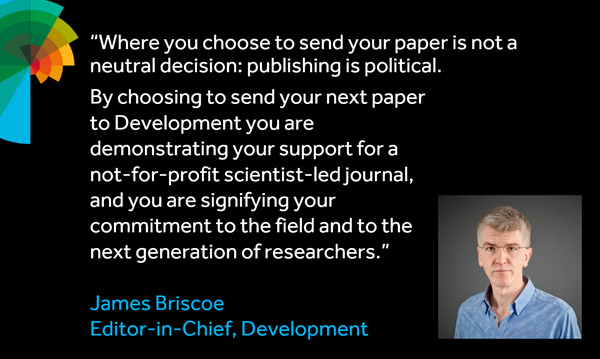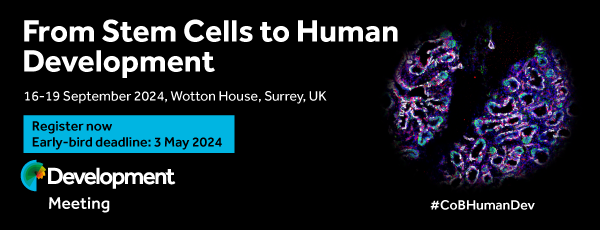Issues
-
Cover image
Cover Image

Cover: Scanning electron micrograph of multiciliated cells (MCCs) of the mouse trachea. Hundreds of cilia on each MCC beat metachronously to clear pathogen- and pollutant-laden mucus, and help maintain health of the airways. Image credit: Chee Peng Ng, Hao Lu and Sudipto Roy. See Research article by Lu et al. (dev172643).
- PDF Icon PDF LinkTable of contents
- PDF Icon PDF LinkIssue info
RESEARCH HIGHLIGHTS
EDITORIAL
A focus on scope
Summary: In this Editorial, we take stock of the ever-evolving scope of Development, which reflects changes in the field and future priorities for the journal.
SPOTLIGHT
The expanding repertoire of hereditary information carriers
Summary: Emerging evidence on the phenomenon of non-DNA sequence-based inheritance in multiple species, including mammals, urges a rethinking of the nature of hereditary information carriers and the ways in which they encode heritable traits.
PRIMER
DamID as a versatile tool for understanding gene regulation
Summary: This Primer provides an overview of DNA adenine methyltransferase identification (DamID), which is used to profile genome-wide chromatin interactions, and introduces recent improvements to the technology.
HUMAN DEVELOPMENT
A wave of WNT signaling balanced by secreted inhibitors controls primitive streak formation in micropattern colonies of human embryonic stem cells
Highlighted Article: Analysis of human embryonic stem cell micropatterns reveals that E-cadherin mediates a WNT-induced epithelial-to-mesenchymal wave analogous to primitive streak extension and DKK1 controls the extent and duration of this patterning.
STEM CELLS AND REGENERATION
Revealing cellular and molecular transitions in neonatal germ cell differentiation using single cell RNA sequencing
Summary: Single cell transcriptomic analysis of undifferentiated germ cells in neonatal mouse testes reveals heterogeneity of gene expression across subpopulations and time, identifying potential novel transcriptional regulators during germ cell differentiation.
Axin proteolysis by Iduna is required for the regulation of stem cell proliferation and intestinal homeostasis in Drosophila
Summary: Iduna regulates stem cell proliferation and intestinal homeostasis.
RESEARCH ARTICLES
Maize YABBY genes drooping leaf1 and drooping leaf2 regulate floret development and floral meristem determinacy
Summary: Maize drl1 and drl2 modulate floral meristem activity through a non-cell-autonomous mechanism that signals from lateral organ primordia to the floral meristem to regulate the development of grain-producing florets.
Spatial regulation of the polarity kinase PAR-1 by parallel inhibitory mechanisms
Highlighted Article: Auto-inhibition and regulation by aPKC/PKC-3 function in parallel to restrict the kinase activity of the cell polarity regulator PAR-1 to the posterior cytoplasm of C. elegans zygotes.
bif1, a new BMP signaling inhibitor, regulates embryonic hematopoiesis in the zebrafish
Summary: si:ch73-299h12.2 (bif1), a gene of unknown function in the zebrafish genome, codes for a zinc-finger protein that inhibits BMP signaling and also regulates primitive erythropoiesis and definitive hematopoiesis.
β-Catenin is essential for differentiation of primary myoblasts via cooperation with MyoD and α-catenin
Summary: Differentiation of adult myoblasts requires the interaction of β-catenin with MyoD but not with TCF/LEF; future selective targeting of different β-catenin complexes might allow inhibition of TCF/LEF-dependent fibrosis whilst sparing myoblast differentiation.
A branching gene regulatory network dictating different aspects of a neuronal cell identity
Summary: The Drosophila Tv1 neuropeptide neuron is specified, not by one single regulatory gene, but by several regulators acting in different combinations to govern different aspects of this cell fate.
A core mechanism for specifying root vascular patterning can replicate the anatomical variation seen in diverse plant species
Summary: A gene regulatory network that generates a diarch vascular pattern in Arabidopsis roots can produce the range of patterns seen in flowering plants under different spatial constraints.
Mcidas mutant mice reveal a two-step process for the specification and differentiation of multiciliated cells in mammals
Highlighted Article: Two geminin family proteins function in mammalian multiciliated cell development: GMNC regulates precursor specification and MCIDAS induces multiple basal body formation for multiciliation.
TECHNIQUES AND RESOURCES
A gene expression atlas of embryonic neurogenesis in Drosophila reveals complex spatiotemporal regulation of lncRNAs
Summary: DIV-MARIS, an adapted technique for examining stage- and cell type-specific gene expression, reveals a complex network of mRNAs and lncRNAs expressed in specific cell types during early Drosophila embryonic nervous system development.
Defined conditions for propagation and manipulation of mouse embryonic stem cells
Summary: Detailed protocols for the propagation, manipulation and differentiation of mouse embryonic stem cells, with tips for minimising variability and improving the efficiency, reproducibility and reliability of embryonic stem cell culture.
Multi-sample SPIM image acquisition, processing and analysis of vascular growth in zebrafish
Summary: A novel dedicated multi-sample light sheet imaging, processing and analysis platform is presented, and its value in diverse quantitative long-term imaging studies, such as vascular growth in zebrafish, is demonstrated.
Call for papers: Uncovering Developmental Diversity

Development invites you to submit your latest research to our upcoming special issue: Uncovering Developmental Diversity. This issue will be coordinated by our academic Editor Cassandra Extavour (Harvard University, USA) alongside two Guest Editors: Liam Dolan (Gregor Mendel Institute of Molecular Plant Biology, Austria) and Karen Sears (University of California Los Angeles, USA).
Choose Development in 2024

In this Editorial, Development Editor-in-Chief James Briscoe and Executive Editor Katherine Brown explain how you support your community by publishing in Development and how the journal champions serious science, community connections and progressive publishing.
Journal Meeting: From Stem Cells to Human Development

Register now for the 2024 Development Journal Meeting From Stem Cells to Human Development. Early-bird registration deadline: 3 May. Abstract submission deadline: 21 June.
Pluripotency of a founding field: rebranding developmental biology

This collaborative Perspective, the result of a workshop held in 2023, proposes a set of community actions to increase the visibility of the developmental biology field. The authors make recommendations for new funding streams, frameworks for collaborations and mechanisms by which members of the community can promote themselves and their research.
Read & Publish Open Access publishing: what authors say

We have had great feedback from authors who have benefitted from our Read & Publish agreement with their institution and have been able to publish Open Access with us without paying an APC. Read what they had to say.



